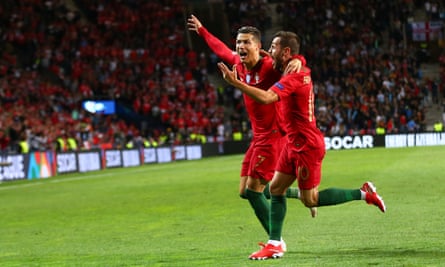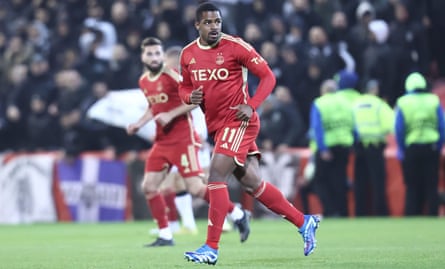It was business as usual. A couple of weeks earlier, they had just concluded the sale of their main striker, who had scored 26 goals in 28 games the previous season. Other clubs would be scrambling to find a replacement capable of filling such a gaping hole. Any other club except Benfica. Their first game without Darwin Núñez could have been tricky, especially coming in early August against an FC Midtjylland side that specialises in causing upsets. Yet Benfica overcame the challenge with disarming ease, winning 4-1 to ensure qualification to the next Champions League qualifying round.
More important than the score, however, were the scorers. One goal was scored by Enzo Fernández, their new Argentinian midfielder who would be holding the World Cup aloft six months later before igniting a transfer frenzy among Europe’s leading clubs. The other three were scored by Gonçalo Ramos, a youth product who had been Núñez’s deputy the previous season and has since been sold to Paris Saint-Germain.
With Ramos now at Liverpool, Ramos stepped in seamlessly and took over goalscoring duties in impressive fashion. Benfica not only made it to the Champions League group stage but also topped a group including PSG and Juventus. For that is what Benfica do. Since 2010 they have earned a massive £900m from player sales. Núñez was merely the latest in a very long list of departures that include João Félix, Ederson and Rúben Dias. Few clubs can match Benfica’s ability to develop talent and sell it on for big profits.
It isn’t just Benfica: the big three in Portugal all have a rich tradition of selling highly valued players while remaining competitive. In the list of clubs who have generated money through player sales in the past decade, Porto are in 10th place. Sporting follow just behind. Benfica are top.
Yet they stay competitive as their regular forays deep into European competition prove. Benfica and Porto are shoulder-to-shoulder in Uefa’s club coefficients, lying 18th and 19th respectively. The leading Scottish club, Rangers, currently hold the 31st spot, which is just above Sporting (33rd) and Braga (39th). In doing so the Portuguese sides have become the envy of Europe, especially in those countries who do not boast a league that can command millions in TV rights.
Granted, Portugal’s population of 10 million makes it nearly twice the size of Scotland and its TV rights generate around £160m, dwarfing Scotland’s £30m deal. But there is not a huge difference between the infrastructure of the Old Firm and the big three in Portugal: their stadiums, fanbase, facilities are all comparable. So why are they achieving much more with their resources?
There are three aspects of the Portuguese success story. The first, and perhaps most overlooked, relates to quality of coaches. It isn’t just José Mourinho, but Jorge Jesus (winner of the Copa Libertadores along with several other Portuguese titles), André Villas-Boas and Leonardo Jardim (who have both enjoyed success in various parts of Europe), Nuno Espírito Santo who helped revive Wolves, while Ruben Amorim is making his name at Sporting. On a national level, Fernando Santos excelled with Greece before winning the European Championship and Nations League with Portugal.
Portugal exports coaches all over the world. Upcoming Portuguese coaches not only have high-profile role models who give them the confidence; their reputation makes it easier for them to get jobs overseas. Funnily enough, two of these managers – Mourinho and Villas-Boas – received part of their coaching education in Scotland, at Largs. Portuguese managers work in a tight-knit coaching community where ideas circulate freely. At the same time, a lack of resources at all but the biggest clubs forces coaches to be creative in finding solutions to their problems.
With high-quality coaches comes world-class players. Benfica, for example, have nurtured João Félix, Rúben Dias and Renato Sanches, who were sold for a combined £200m. The club believes it is an investment to recruit players, develop them for years and promote them until they reach the first team. Their recruitment strategy focuses on players aged between six and 13. Once talented youngsters are identified, they are given a personal programme to work on alongside team training.

Their scouting network finds players who have leadership and communication skills, not just technical ability. Bernardo Silva is a good example. He was not considered outstanding when he arrived at the club but Benfica showed patience, nurtured him and developed him into an international player and treble winner with Manchester City.
The same applies at Sporting, whose academy has developed some of the biggest names in football, including Luís Figo and Cristiano Ronaldo. They have an exceptional scouting network, mainly spread across Portugal, with more than a hundred scouts employed to recruit youngsters from the age of seven. The academy’s training style is categorised for different age groups, with key focus areas clearly defined for each group. These two clubs have fuelled Portugal’s success at youth level. Over the past decade, Portugal have won the Under-17 (2016) and Under-19 (2018) European Championship, as well as finishing runners-up in the Under-21 competition (2015).
Effective scouts and coaches will only take a team so far. Clubs also need to bring in talent from outside. And, when you don’t have money to throw around, you have to be clever and find an edge over richer competition. This is the area where Porto tend to excel. Over the years they have signed the likes of James Rodríguez, Éder Militão and Luis Díaz for next to nothing and then moved them on for a huge profit.
Those results are not accidental. “We have to be permanently studying the youth market,” says Jorge Nuno Pinto da Costa, the Porto president. “This is what allows us to keep fighting, despite having a budget 20 times less in respect to income. Year after year we lose great players and then put our faith in players with great potential.”
Porto have the system in place to spot these players – a huge network of people across the globe always looking for players. Speaking to France Football, Porto’s former general director Antonio Henrique explained their approach: “We work with 250 scouts around the world in countries that make sense for football, because we will not send anyone to Bangladesh. We have internal and external scouts, which are divided into several levels of observation, which allows a player to be viewed by several people. They work with a shadow team, which is a set of players who are identified from various leagues, who are capable of being hired by Porto.”
For these players, the move to Porto is ideal. Players know they will play at a decent level while developing their talent and possibly winning a few trophies – and Porto will not stand in their way should a good offer come along. The club is, in many ways, the ideal stepping stone. Porto have worked hard for years to build the right setting for players to ensure they settle quickly.
The idea of constantly rebuilding is now ingrained in Portuguese football. If it was easy, everyone would be doing it but some clubs are trying to emulate that style. Aberdeen changed their approach a couple of years ago and now put more faith in homegrown talent. It has already proven its worth: the sales of Calvin Ramsey and Lewis Ferguson last summer generated more than £7m.
Part of that money has been re-invested into the squad, with the focus being on bringing in players who have the capacity to improve. Chief among them was Luís “Duk” Lopes, a 23-year-old Cape Verde international striker who, incidentally, was signed from Benfica’s B side. With his dynamic, powerful running and goalscoring ability, Duk has quickly established himself as one of the Scottish Premiership’s stars. He is being scouted by various clubs and could be the next player to move on from Aberdeen for a big transfer fee.

Duk has been quite transparent about his ambitions. “I knew the Scottish league has often been a springboard for players to reach the English Championship, and even the Premier League. That is one of the reasons I chose to come here. I came here with the aim of getting to England.”
Perhaps not the most inspiring of words for Aberdeen fans, who might not appreciate their team being seen as a launchpad to better things. But, placed within the context of what the club is trying to do, his words are encouraging. Especially when he adds: “When I arrived, I realised that Aberdeen are a big club, with a large fanbase. They have similarities with Benfica. They have a great history in Europe, although they are in a rebuilding phase right now.”
If that message reaches other potential targets, it becomes easier to get the right players in. Signing and developing players is only part of the equation, however. They also need the right platform and that means sustained runs in Europe. This figures in Aberdeen’s thinking.
Steve Gunn, the club’s director of football, says their target is making it into the top 100 clubs in Uefa’s rankings. “The reason we picked that target is because there were clubs within that 100 we are envious of,” he explained. “We felt if those kind of clubs can break into the top 100, then why can’t Aberdeen, with our fanbase, infrastructure, training ground, and plans for the new stadium? Delivering top 100 means two things. Finishing in the top two or three in the league regularly – as you need to be qualifying for Europe on a regular basis – and winning things domestically.”
The buy, develop and sell model is one they are openly targeting. “What we are looking at is clubs in countries of a similar size to Scotland – Croatian and Scandinavian clubs, teams that have been competitive in the group stages. Teams that have been punching above their weight, like Malmö and Rijeka, who we came up against in Europe recently, that is something they have done successfully.
“The other thing about the top 100 is players’ value increases substantially when they play at that level. Rijeka did well on that front and would sell players for a few hundred thousand euros. But as soon as they got into the group stages, their players’ values went up to seven figures. That is something we would like to try to do.”

It will be interesting to see whether their experiment succeeds. It can be a difficult sell for the fans as no one is comfortable seeing their club a springboard to bigger things. Yet early indications are positive: this summer Ylber Ramadani was sold to Lecce for 10 times the fee they paid to sign him from MTK Budapest 12 months earlier. It might not be Núñez to Liverpool territory, but it could be an encouraging first step to seeing more Scottish clubs rubbing shoulders with the Portuguese giants.